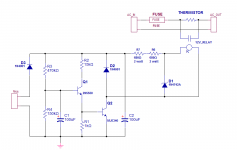Im sorry for asking. Ive looked and looked for a simple soft start circuit but all ive found are 20+ component setups and almost need a pcb etched.
Is there something simple i could air wire That could run off of the secondaries or mains?
Is there something simple i could air wire That could run off of the secondaries or mains?
the safest way is to run a separate supply from a separate 12Vac to 24Vac transformer.
This is switched on and supplies power to the control circuit. A timer, a resistor and/or thermistor and a bypass relay.
This is switched on and supplies power to the control circuit. A timer, a resistor and/or thermistor and a bypass relay.
This is mine:

Doesn't use a separate supply, it uses the positive rail of the supply it works with. About a 1 second delay before the relay shorts the thermistor. Safer than resistor types - the thermistor is capable of carrying the full current even if the relay fails to close.
R6 and R7 value is calculated from the rail voltage and the relay used.

Doesn't use a separate supply, it uses the positive rail of the supply it works with. About a 1 second delay before the relay shorts the thermistor. Safer than resistor types - the thermistor is capable of carrying the full current even if the relay fails to close.
R6 and R7 value is calculated from the rail voltage and the relay used.
What about this. use 40ohm thermistors at the mains (300 watt load)and put the relay coil across the secondaries with a resistor and diode? a 24vdc coil will trigger at 17-18v. If i put i resistor in line wouldnt it trigger closer to rail voltage?
this is a really bad way to activate/not activate the relay.What about this. use 40ohm thermistors at the mains (300 watt load)and put the relay coil across the secondaries with a resistor and diode? a 24vdc coil will trigger at 17-18v. If i put i resistor in line wouldnt it trigger closer to rail voltage?
The resistor/thermistor will reduce the voltage supplied to the transformer.
This in turn reduces the secondary voltage from the transformer.
In the meantime the rectified voltage has to pass the resistor and the relay.
The relay might pull in or it might not.
Once the relay has pulled in the primary gets the full mains voltage and the relay+ resistor get the full secondary voltage.
If you want to ensure that the relay does not overheat, you take the risk that that a slightly low voltage on the mains may never pull in the relay.
A proper timed delay for the relay control is far better.
PS for just plain and dirty
TDRSOXP-120V
it has 120vac trigger so shouldnt this be all i need period?
TDRSOXP-120V
it has 120vac trigger so shouldnt this be all i need period?
- Status
- Not open for further replies.